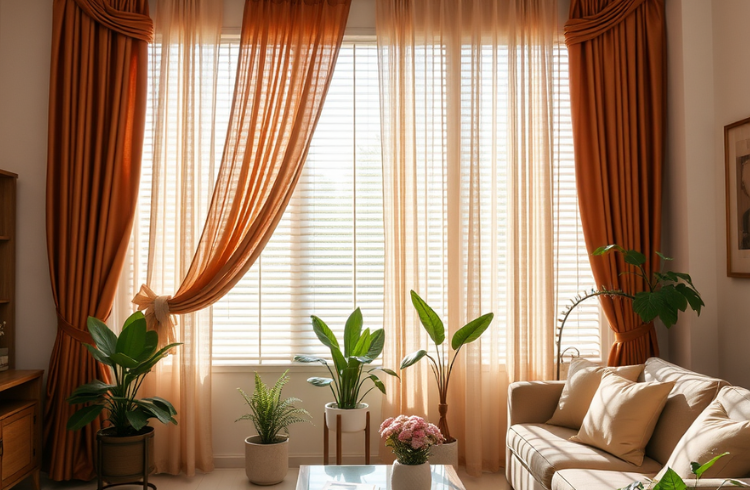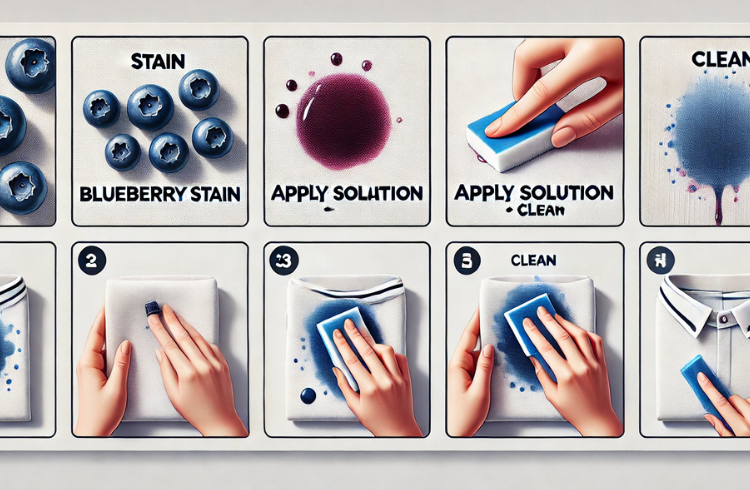Introduction
Window treatments play a vital role in enhancing the aesthetics and functionality of any space. Layering curtains over blinds has gained immense popularity among homeowners and interior designers alike.
This 2024 comprehensive guide reveals how this combination not only enhances your room’s visual appeal but also provides practical benefits like increased privacy, enhanced light control, and improved insulation. We will cover the benefits, latest design trends, pro installation tips, and how to perfectly blend style with practicality.
| Aspect | Details |
| Purpose | Boosts privacy, controls lighting, elevates style, and improves insulation. |
| Best Blind Types | Venetian, roller, Roman, vertical blinds pair well with curtains. |
| Best Curtain Types | Sheer, blackout, thermal, decorative drapes tailored to needs. |
| Design Trends | Contrasting textures, neutral palettes, and bold patterns dominate. |
| Installation Tips | Mount curtains higher & wider than blinds for polished look. |
| Light Control | Blackout for darkness; sheer curtains for soft, diffused light. |
| Privacy Benefits | Dual layers significantly boost privacy in bedrooms & living rooms. |
| Material Choices | Cotton, linen, polyester, velvet—choose based on style and needs. |
| Cost Considerations | Varies by fabric quality, blind style & hardware; options for every budget. |
| Maintenance | Regular dusting for blinds; follow fabric care for curtains (machine wash/dry clean). |
Understanding the Basics of Window Treatments
To fully appreciate the benefits of layering curtains over blinds, it’s essential to understand the key types of window treatments available today.
Types of Window Treatments
- Blinds: Adjustable slats made from wood, faux wood, vinyl, aluminum, and more for customizable light and privacy control.
- Shades: Fabric or materials that roll or lift—popular types include roller, Roman, and cellular shades.
- Curtains: Fabric panels available in a wide range of materials and opacity levels, from sheer to blackout.
Combining curtains and blinds maximizes the advantages of both, delivering superior functionality and style.
The Benefits of Layering Curtains Over Blinds
Layering curtains with blinds enhances both the aesthetic appeal and functionality of your window treatments:

Enhanced Aesthetics
Adding layers introduces visual depth and richness, transforming windows into stylish focal points. Mixing different textures and colors complements your décor for an elevated look.
Improved Light Control
Blinds allow fine-tuned light adjustment, while curtains add options for opacity. Together, they enable precise ambiance control throughout the day.
Increased Privacy
Blinds provide daytime privacy but can become transparent at night when lights are on. Adding curtains ensures full privacy anytime, perfect for bedrooms and living rooms.
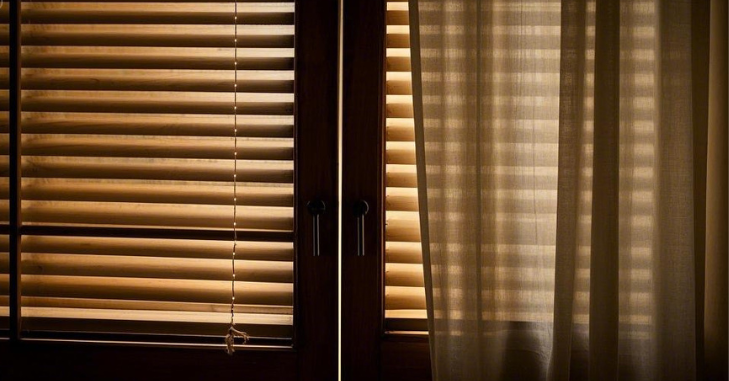
Better Insulation
The fabric layer of curtains improves thermal insulation, keeping your home warmer in winter and cooler in summer, thus lowering energy bills.
Versatility
Layered treatments offer flexibility—switch either curtains or blinds independently to refresh your décor with ease, accommodating seasonal or style changes.
Current Design Trends
Layering curtains over blinds remains a top trend in contemporary design, featuring several popular styles:
Minimalist Aesthetic
Minimalist designs emphasize clean lines and simplicity. Light, sheer curtains paired with sleek blinds create an airy and modern environment without compromising light control.
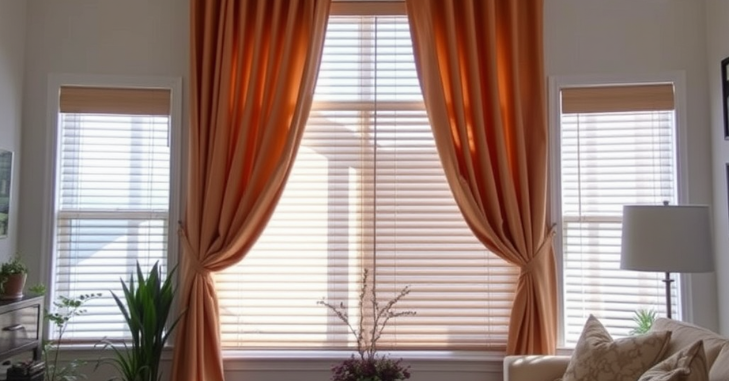
Bohemian Style
Add color and personality with patterned or vibrant curtains combined with natural wood or bamboo blinds for a warm, boho-inspired atmosphere.
Industrial Chic
Industrial interiors pair dark, heavy curtains with metal or faux wood blinds, mixing raw materials with cozy accents for balanced style.
Eco-Friendly Choices
Sustainability grows in importance; opt for organic fabric curtains and blinds made from reclaimed wood or bamboo to create environmentally conscious layered treatments.

Choosing the Right Curtains and Blinds
Selecting the ideal curtain and blind combo is crucial for aesthetic unity and functionality. Here’s how to make smart choices:
Material Selection
- Blinds: Durable materials like faux wood and aluminum are excellent for high-usage areas; natural wood blends warmth and timeless appeal.
- Curtains: Match fabric weight and texture to your lighting and privacy needs—sheers for softness, velvet or thermal fabrics for insulation and darkness.
Colour and Pattern Coordination
- Colour: Coordinate curtain hues with your room palette. Neutral tones can soften harsh blinds; bold patterns add visual interest.
- Pattern: When mixing patterns, ensure harmony. Use a shared color or theme to maintain cohesiveness.
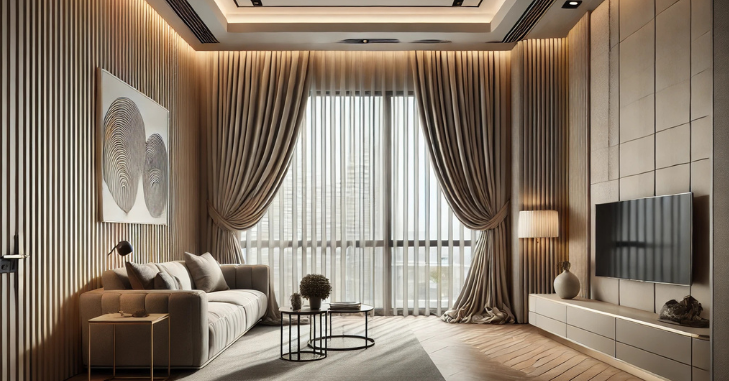
Length and Style
- Curtains: For a sophisticated look, curtains typically hover just above the floor. Popular styles include grommet, rod pocket, and tab top.
- Blinds: Ensure snug mounts inside the window frame for a clean finish.
Installation Tips for Layered Window Treatments
Perfect installation is key to maximizing both aesthetic and function. Keep these 2024 best practices in mind:
Measuring
- Measure precisely: Get accurate window width and height for both curtains and blinds.
- Decide mounting style: Inside or outside mounts for blinds affect curtain rod position and curtain length.
Installing Blinds
- Follow instructions: Use manufacturer guidelines to ensure a secure, level installation.
- Tools ready: Have drill, level, screwdriver, anchors for efficient setup.
Installing Curtains
- Mount rod high and wide: Install bracket well above window frame and extend beyond blind width for an elegant, expansive look.
- Hang curtains evenly: Slide curtains onto the rod, spacing clips or rings evenly for smooth operation.
Layering
- Install order: Blinds come first, then curtains, allowing full functionality and easy access.
- Test operation: Verify curtains open fully without obstructing blinds.
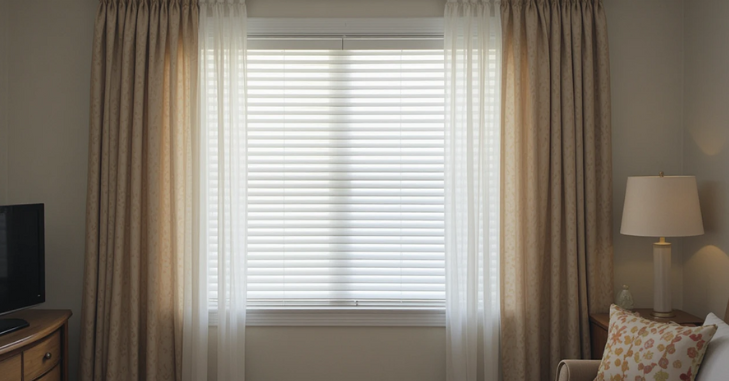
Light Control and Privacy
Layering curtains and blinds provides exceptional light and privacy management:
Adjust blind slats to direct natural light precisely, while fully opening curtains maximize brightness during the day. At night, closing curtains along with blinds ensures total privacy and coziness. For daytime privacy without blocking light, sheer curtains combined with blinds create a softly filtered environment.
Best Curtain and Blind Combinations
| Curtain Type | Best Blind Pairing | Ideal Room |
| Sheer Curtains | Wooden or Faux Wood Blinds | Living Room, Dining Room |
| Blackout Curtains | Roller or Cellular Blinds | Bedroom, Home Theater |
| Linen Curtains | Bamboo Blinds | Boho-Chic Interiors |
| Velvet Curtains | Roman Blinds | Formal Living Room, Office |
| Cotton Curtains | Venetian Blinds | Kitchen, Bathroom |
Maintenance and Care
- Regular dusting: Use microfiber cloths or dusters to keep blinds free of dust and debris.
- Deep cleaning: Follow manufacturer instructions for washing or removing blinds to maintain their condition.
- Curtain care: Always follow fabric care labels; some fabrics are machine washable, others require dry cleaning (Many curtains).
- Ironing and steaming: Use a garment steamer or low-heat iron to remove wrinkles from curtains.
- Routine inspections: Check curtains and blinds regularly for wear, damage, or tears and address promptly to prolong lifespan.
Conclusion
Layering curtains over blinds is an elegant, practical solution that enhances your home’s style, light control, and privacy in 2024.
By following current trends, carefully selecting materials, and applying expert installation techniques, you can create beautiful, functional layered window treatments that elevate your interior and withstand daily use.
Discover more about “Finding the Perfect Curtains and Blinds for Your Dubai Home” anytime through our “Home Improvement” Category for further inspiration and expert guidance.
FAQs
Yes, layering curtains over blinds is an excellent method to boost privacy, enhance insulation, and add a stylish dimension to your windows.
Venetian, roller, Roman, and vertical blinds pair beautifully with curtains, offering a blend of style and function.
Mount the curtain rod higher and wider than the window frame and blinds to create an elegant layered look.
Absolutely. Curtains provide an extra layer that reduces heat loss in winter and heat gain in summer, improving insulation.
Yes, the combined insulation effect helps maintain a consistent indoor temperature, potentially lowering heating and cooling costs.
Yes, layered treatments can be customized to fit any window size or shape, ensuring tailored style and functionality for every space.

